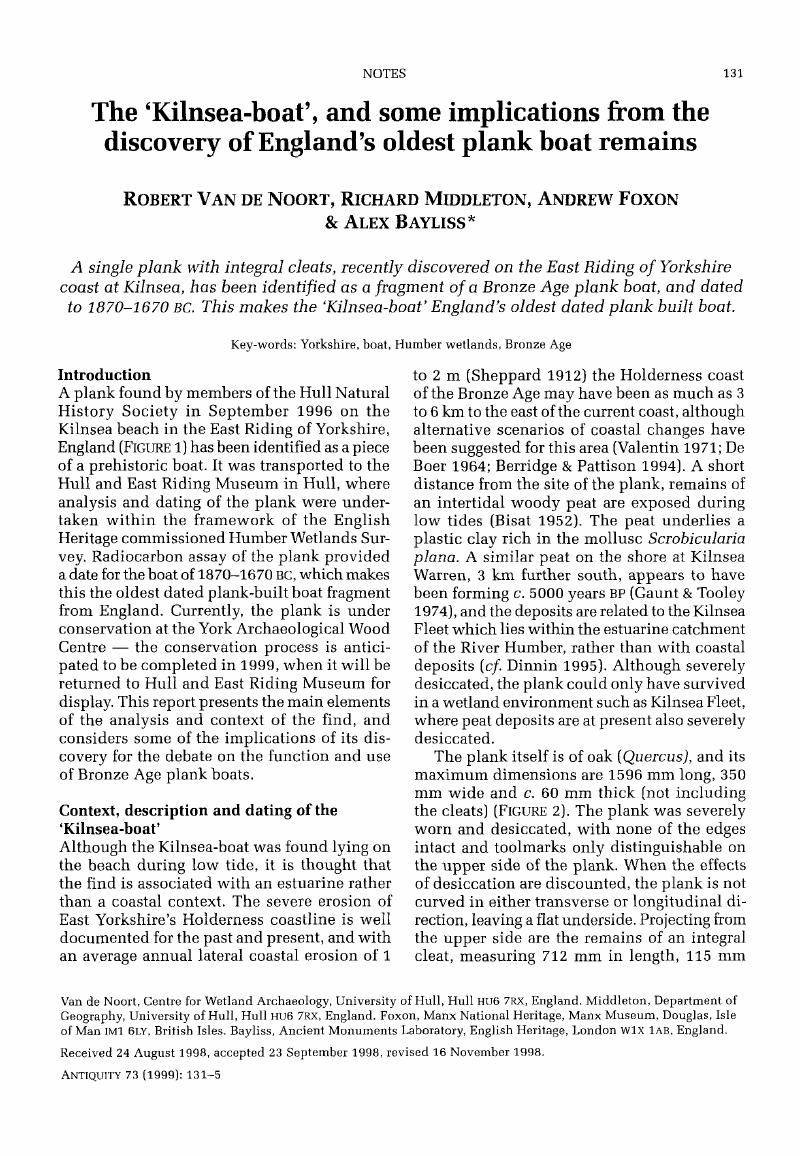Crossref Citations
This article has been cited by the following publications. This list is generated based on data provided by Crossref.
van de Noort, Robert
and
Ellis, Stephen
2000.
The Humber estuary: managing the archaeological resource in a dynamic environment.
Geological Society, London, Special Publications,
Vol. 175,
Issue. 1,
p.
419.
Wright, Edward V.
Hedges, Robert E. M.
Bayliss, Alex
and
Van de Noort, Robert
2001.
New AMS radiocarbon dates for the North Ferriby boats—a contribution to dating prehistoric seafaring in northwestern Europe.
Antiquity,
Vol. 75,
Issue. 290,
p.
726.
Clark, Peter
2005.
Shipwrights, Sailors and Society in the Middle Bronze Age of NW Europe.
Journal of Wetland Archaeology,
Vol. 5,
Issue. 1,
p.
87.
Lillie, Malcolm
2005.
Deconstructing Reconstruction: The Bronze Age Sewn Plank Boats from North Ferriby, River Humber, England, UK and their Context.
Journal of Wetland Archaeology,
Vol. 5,
Issue. 1,
p.
97.
Chapman, Henry P.
and
Chapman, Philip R.
2005.
Seascapes and Landscapes-the Siting of the Ferriby Boat Finds in the Context of Prehistoric Pilotage.
International Journal of Nautical Archaeology,
Vol. 34,
Issue. 1,
p.
43.
SAMSON, ALICE V.M.
2006.
OFFSHORE FINDS FROM THE BRONZE AGE IN NORTH‐WESTERN EUROPE: THE SHIPWRECK SCENARIO REVISITED.
Oxford Journal of Archaeology,
Vol. 25,
Issue. 4,
p.
371.
Van de Noort, Robert
2006.
Argonauts of the North Sea - a Social Maritime Archaeology for the 2nd MillenniumBC.
Proceedings of the Prehistoric Society,
Vol. 72,
Issue. ,
p.
267.
Bayliss, Alex
2009.
Rolling Out Revolution: Using Radiocarbon Dating in Archaeology.
Radiocarbon,
Vol. 51,
Issue. 1,
p.
123.
Richardson, Jane
2011.
Bronze Age Cremations, Iron Age and Roman Settlement and Early Medieval Inhumations at the Langeled Receiving Facilities, Easington, East Riding of Yorkshire.
Yorkshire Archaeological Journal,
Vol. 83,
Issue. 1,
p.
59.
Halkon, Peter
and
Starley, David
2011.
Iron, Landscape and Power in Iron Age East Yorkshire.
Archaeological Journal,
Vol. 168,
Issue. 1,
p.
133.
Richardson, Jane
Weston, Phil
Alldritt, Diane
Carrott, John
Didsbury, Peter
Foster, Alison
Holst, Malin
Makey, Peter
Manby, Terry
and
Walker, Angela
2014.
Earlier Prehistoric Activity and a Later Iron Age and Roman Field System at Beacon Lagoons, Kilnsea, East Riding of Yorkshire.
Yorkshire Archaeological Journal,
Vol. 86,
Issue. 1,
p.
3.
Van de Noort, Robert
Cumby, Brian
Blue, Lucy
Harding, Anthony
Hurcombe, Linda
Hansen, Tom Monrad
Wetherelt, Andy
Wittamore, Jenny
and
Wyke, Andy
2014.
Morgawr: an experimental Bronze Age-type sewn-plank craft based on the Ferriby boats.
International Journal of Nautical Archaeology,
Vol. 43,
Issue. 2,
p.
292.
Staples, Eric
and
Blue, Lucy
2019.
Archaeological, Historical, and Ethnographic Approaches to the Study of Sewn Boats: past, present, and future.
International Journal of Nautical Archaeology,
Vol. 48,
Issue. 2,
p.
269.
Streiffert Eikeland, Katarina
2023.
Female Presence in Maritime Settings–Trade and Warfare.
Journal of Maritime Archaeology,
Vol. 18,
Issue. 2,
p.
129.



